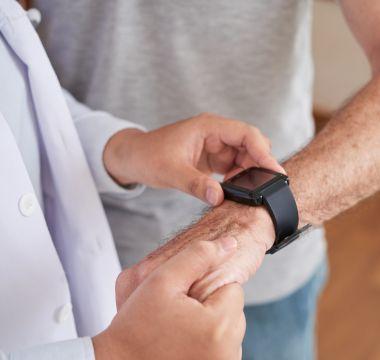Detecting Early Parkinson’s with a Wearable Movement-Tracking Device

According to a new study, data from smart devices may be able to detect Parkinson’s disease years before a diagnosis.
What if a smartwatch could detect Parkinson’s disease (PD) before you knew something was wrong? A new study in Nature Medicine used digital movement sensors, the kind of technology found in smart devices, to detect Parkinson’s disease years before a clinical diagnosis.
By the time a person is diagnosed with Parkinson’s, they have already lost 50% to 70% of dopamine neurons. Their brain cells involved in memory, movement, motivation, mood and attention have degenerated. Due to this reality, researchers are eager to find accurate, affordable and non-invasive tools to help detect Parkinson’s sooner.
The Methods

For this study, researchers used smart devices with a movement tracker to collect information on participants’ movement and activity levels. The study assessed years of data points to find patterns that point to Parkinson’s. Researchers utilized data from a randomly selected group of 103,712 people participating in the UK Biobank, a study of more than 500,000 people aged 40–69 years with ongoing follow-up of clinical status. They used a wrist-worn accelerometer, which can detect movement and rate of speed changes (acceleration), to study average acceleration for each hour of the day, as well as sleep patterns, over a seven-day period.
The Results
Reduction in acceleration can be seen before PD diagnosis. Over the course of two years, 273 participants were diagnosed with Parkinson’s. Another 196 people received a new PD diagnosis more than two years after they collected the data. Remarkably, in the 196 people who received a PD diagnosis after the study, researchers saw a reduction in their average daytime acceleration several years before their PD diagnosis, during what is known as the prodromal stage (where early signs are present but no clinical diagnosis has been made).
No other diagnosis shows a similar pattern. Parkinson’s disease was the only diagnosis associated with a reduction in movement before (the prodromal stage) and after diagnosis. This reduction did not correlate with other diagnoses, including Alzheimer’s, dystonia (a sustained or repetitive muscle twisting, spasm or cramp) or osteoarthritis.
Sleep disturbances are more marked in PD than in other disorders. Using the movement data, researchers found reduced quality and duration of sleep both before and after PD diagnosis compared to people without PD. People diagnosed with PD slept fewer hours overall, had fewer consecutive hours of sleep and slept more frequently during the day than both people without PD and those in the prodromal stage. Sleep deterioration was observed in other diagnoses, but not to the same extent as seen in PD.
Acceleration data predicts prodromal PD. To test whether prodromal PD could be predicted based on the data, researchers created a model using age, sex and average acceleration. They successfully identified cases of Parkinson’s before diagnosis from the UK Biobank population. This model was better at predicting PD than a model that relied on other PD markers, including genetics, lifestyle (such as smoking or heavy alcohol use) and blood biomarkers.
Acceleration data predicts time to diagnosis. Finally, researchers leveraged the data to build a model to accurately predict the amount of time until a PD diagnosis. They also found that their model could predict the probability of not receiving a Parkinson’s diagnosis in the following several years.
While several studies have shown that changes in movement (including the use of digital gait measures) can be associated with prodromal PD, this is the first study to show the potential usefulness of accelerometers in detecting PD years before a clinical diagnosis.
Highlights
- Wrist-worn movement trackers could detect changes in average acceleration years before a PD diagnosis, during the prodromal stage.
- Only participants with PD experienced a reduction in acceleration both before and following a diagnosis, suggesting this measure is disease-specific and can potentially be used in early identification for people likely to be diagnosed with PD.
- The accelerometry model could predict who would develop PD, and when the diagnosis might be expected.
What does this mean?
This study shows that the reduction in acceleration is PD-specific and can be detected years before a clinical PD diagnosis. This may mean that in the future, doctors may be able to leverage activity data from a smart device to diagnose Parkinson’s disease earlier.
However, more studies are needed before smart device data become a widely available diagnostic tool. Overall, more research is needed to help clinicians detect and confirm an early Parkinson’s diagnosis.
What do these findings mean to the people with PD right now?
People who are concerned that they may be experiencing Parkinson’s symptoms should talk to a healthcare provider.
Learn More
The Parkinson’s Foundation believes in empowering the Parkinson’s community through education. Learn more about PD and the topics in this article through our below resources, or by calling our free Helpline at 1-800-4PD-INFO (1-800-473-4636) for answers to your Parkinson’s questions.
Related Materials
Related Blog Posts

A Balancing Act - Freezing and Fall Prevention in Parkinson's

How to Spot the Early Signs of Parkinson's
